Detailed Case Study: Business Operations of the Moana Organization
VerifiedAdded on 2019/09/23
|15
|3583
|640
Case Study
AI Summary
This case study examines the Moana Organization, a prominent Maori-owned fisheries company in New Zealand. The report provides an overview of Moana's business activities, including its involvement in fin fish, abalone, oysters, and lobster fisheries. It analyzes strategic issues such as sustainability concerns, competition within the industry, and the impact of climate change. A SWOT analysis is conducted to identify the company's strengths, weaknesses, opportunities, and threats. The analysis highlights Moana's position as a leading Maori-owned firm, its sustainable practices, and its challenges related to untapped resources, low-value addition, and competition. The report also discusses the impact of Maori culture on business activities and addresses communication issues within the organization. The case study provides valuable insights into the company's operations and strategic challenges, offering a comprehensive understanding of Moana's market position and future prospects.

Running Head: CASE STUDY ON MAORI ORGANIZATION
Case Study on Maori Organization
Case Study on Maori Organization
Paraphrase This Document
Need a fresh take? Get an instant paraphrase of this document with our AI Paraphraser
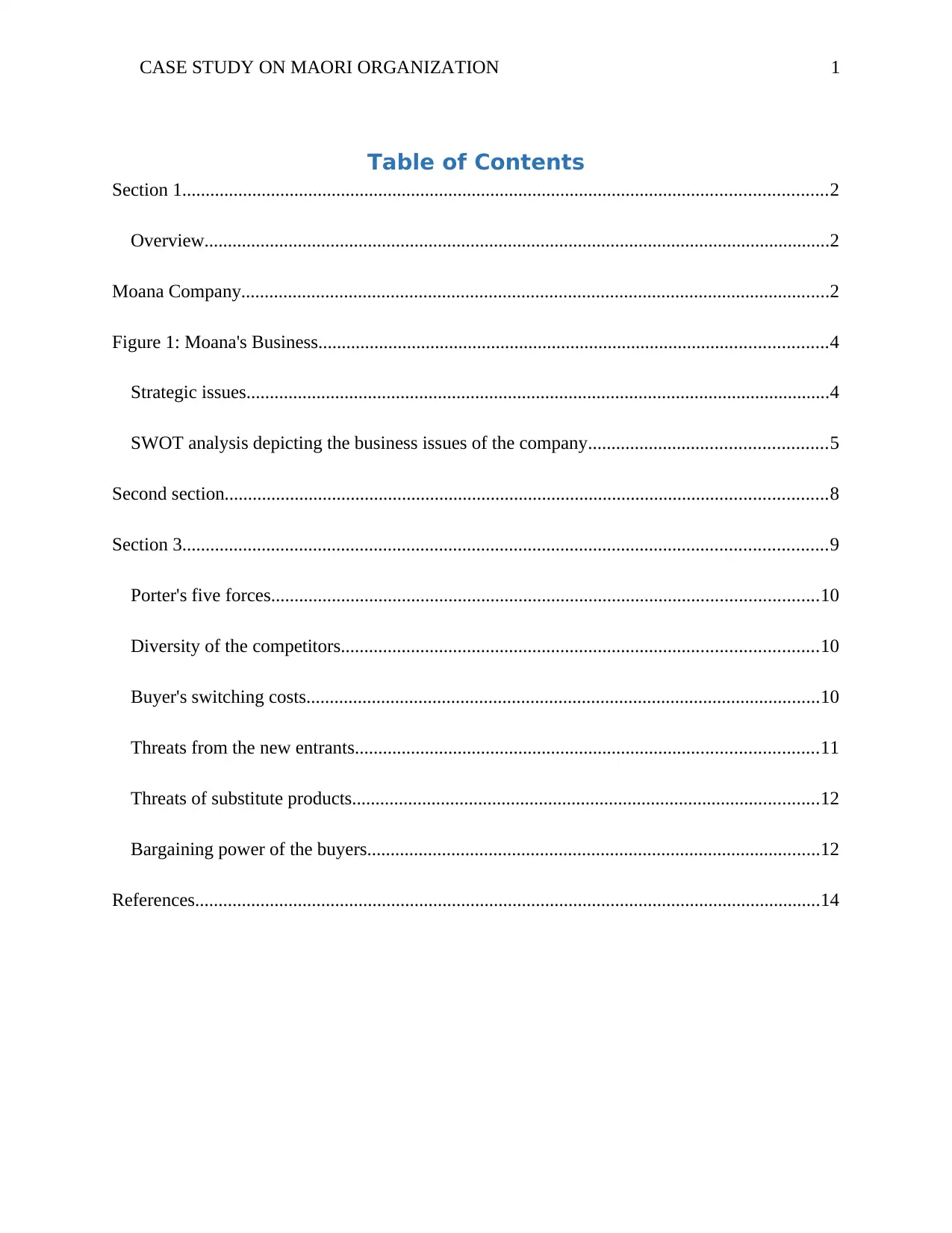
CASE STUDY ON MAORI ORGANIZATION 1
Table of Contents
Section 1..........................................................................................................................................2
Overview......................................................................................................................................2
Moana Company..............................................................................................................................2
Figure 1: Moana's Business.............................................................................................................4
Strategic issues.............................................................................................................................4
SWOT analysis depicting the business issues of the company...................................................5
Second section.................................................................................................................................8
Section 3..........................................................................................................................................9
Porter's five forces.....................................................................................................................10
Diversity of the competitors......................................................................................................10
Buyer's switching costs..............................................................................................................10
Threats from the new entrants...................................................................................................11
Threats of substitute products....................................................................................................12
Bargaining power of the buyers.................................................................................................12
References......................................................................................................................................14
Table of Contents
Section 1..........................................................................................................................................2
Overview......................................................................................................................................2
Moana Company..............................................................................................................................2
Figure 1: Moana's Business.............................................................................................................4
Strategic issues.............................................................................................................................4
SWOT analysis depicting the business issues of the company...................................................5
Second section.................................................................................................................................8
Section 3..........................................................................................................................................9
Porter's five forces.....................................................................................................................10
Diversity of the competitors......................................................................................................10
Buyer's switching costs..............................................................................................................10
Threats from the new entrants...................................................................................................11
Threats of substitute products....................................................................................................12
Bargaining power of the buyers.................................................................................................12
References......................................................................................................................................14

CASE STUDY ON MAORI ORGANIZATION 2
Overview
Māori organizations embody the Māori societies in all fields of life. This report discusses the
case study of Moana and its business activities. This will be based on critical analysis and
evaluation of the system.
Moana Company
The company that has been taken into consideration for carrying out this entire project is Moana
in New Zealand. It is one of the most famous Māori organizations as per the list provided by
Delloite (Moana, 2015). It is the largest Māori-owned fisheries companies in New Zealand at
present. Moana New Zealand is regarded as one of the trading names of Aoteroa Fisheries
Limited, the firm was set up under the Te Ohu Kai Moana that followed the 1992 Sealord
Settlement. On the other hand, the assets of the company are worth more than $540 million as
well as the revenue recorded is around $175 million and in the year 2017 has turned the company
into one of the most of dominant players in the entire New Zealand fishing industry (Moana,
2015).
Business activities of the Māori firm-
Moana have its fisheries business mainly in the following sections such as: Fin Fish, Abalone,
Oysters, Lobster, Wild Abalone and Blue Abalone.
The business activities of any type of company mainly involve the activities in which they are
engaged for one of the main purposes that is making a profit. The business activities consist of
Overview
Māori organizations embody the Māori societies in all fields of life. This report discusses the
case study of Moana and its business activities. This will be based on critical analysis and
evaluation of the system.
Moana Company
The company that has been taken into consideration for carrying out this entire project is Moana
in New Zealand. It is one of the most famous Māori organizations as per the list provided by
Delloite (Moana, 2015). It is the largest Māori-owned fisheries companies in New Zealand at
present. Moana New Zealand is regarded as one of the trading names of Aoteroa Fisheries
Limited, the firm was set up under the Te Ohu Kai Moana that followed the 1992 Sealord
Settlement. On the other hand, the assets of the company are worth more than $540 million as
well as the revenue recorded is around $175 million and in the year 2017 has turned the company
into one of the most of dominant players in the entire New Zealand fishing industry (Moana,
2015).
Business activities of the Māori firm-
Moana have its fisheries business mainly in the following sections such as: Fin Fish, Abalone,
Oysters, Lobster, Wild Abalone and Blue Abalone.
The business activities of any type of company mainly involve the activities in which they are
engaged for one of the main purposes that is making a profit. The business activities consist of
⊘ This is a preview!⊘
Do you want full access?
Subscribe today to unlock all pages.

Trusted by 1+ million students worldwide
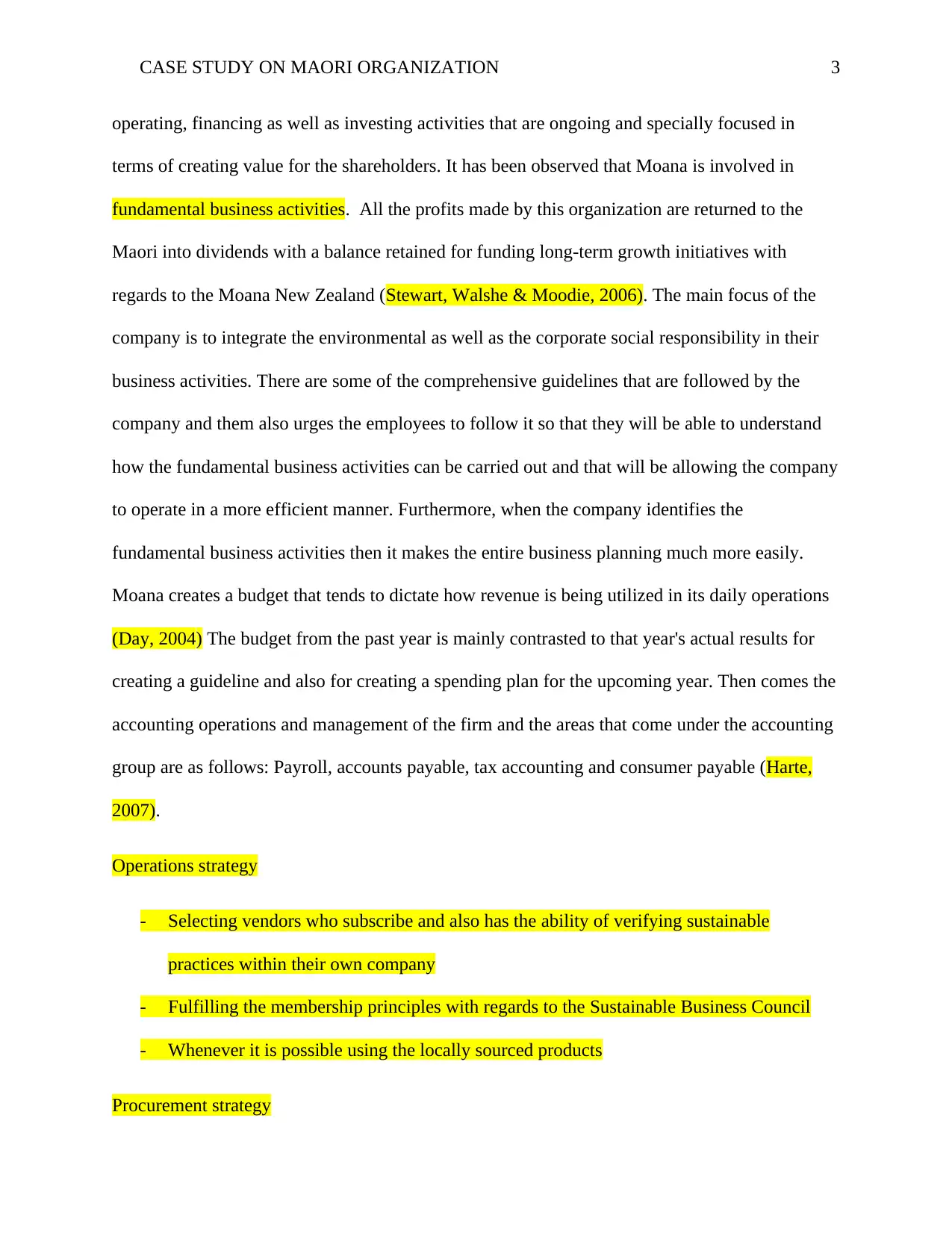
CASE STUDY ON MAORI ORGANIZATION 3
operating, financing as well as investing activities that are ongoing and specially focused in
terms of creating value for the shareholders. It has been observed that Moana is involved in
fundamental business activities. All the profits made by this organization are returned to the
Maori into dividends with a balance retained for funding long-term growth initiatives with
regards to the Moana New Zealand (Stewart, Walshe & Moodie, 2006). The main focus of the
company is to integrate the environmental as well as the corporate social responsibility in their
business activities. There are some of the comprehensive guidelines that are followed by the
company and them also urges the employees to follow it so that they will be able to understand
how the fundamental business activities can be carried out and that will be allowing the company
to operate in a more efficient manner. Furthermore, when the company identifies the
fundamental business activities then it makes the entire business planning much more easily.
Moana creates a budget that tends to dictate how revenue is being utilized in its daily operations
(Day, 2004) The budget from the past year is mainly contrasted to that year's actual results for
creating a guideline and also for creating a spending plan for the upcoming year. Then comes the
accounting operations and management of the firm and the areas that come under the accounting
group are as follows: Payroll, accounts payable, tax accounting and consumer payable (Harte,
2007).
Operations strategy
- Selecting vendors who subscribe and also has the ability of verifying sustainable
practices within their own company
- Fulfilling the membership principles with regards to the Sustainable Business Council
- Whenever it is possible using the locally sourced products
Procurement strategy
operating, financing as well as investing activities that are ongoing and specially focused in
terms of creating value for the shareholders. It has been observed that Moana is involved in
fundamental business activities. All the profits made by this organization are returned to the
Maori into dividends with a balance retained for funding long-term growth initiatives with
regards to the Moana New Zealand (Stewart, Walshe & Moodie, 2006). The main focus of the
company is to integrate the environmental as well as the corporate social responsibility in their
business activities. There are some of the comprehensive guidelines that are followed by the
company and them also urges the employees to follow it so that they will be able to understand
how the fundamental business activities can be carried out and that will be allowing the company
to operate in a more efficient manner. Furthermore, when the company identifies the
fundamental business activities then it makes the entire business planning much more easily.
Moana creates a budget that tends to dictate how revenue is being utilized in its daily operations
(Day, 2004) The budget from the past year is mainly contrasted to that year's actual results for
creating a guideline and also for creating a spending plan for the upcoming year. Then comes the
accounting operations and management of the firm and the areas that come under the accounting
group are as follows: Payroll, accounts payable, tax accounting and consumer payable (Harte,
2007).
Operations strategy
- Selecting vendors who subscribe and also has the ability of verifying sustainable
practices within their own company
- Fulfilling the membership principles with regards to the Sustainable Business Council
- Whenever it is possible using the locally sourced products
Procurement strategy
Paraphrase This Document
Need a fresh take? Get an instant paraphrase of this document with our AI Paraphraser
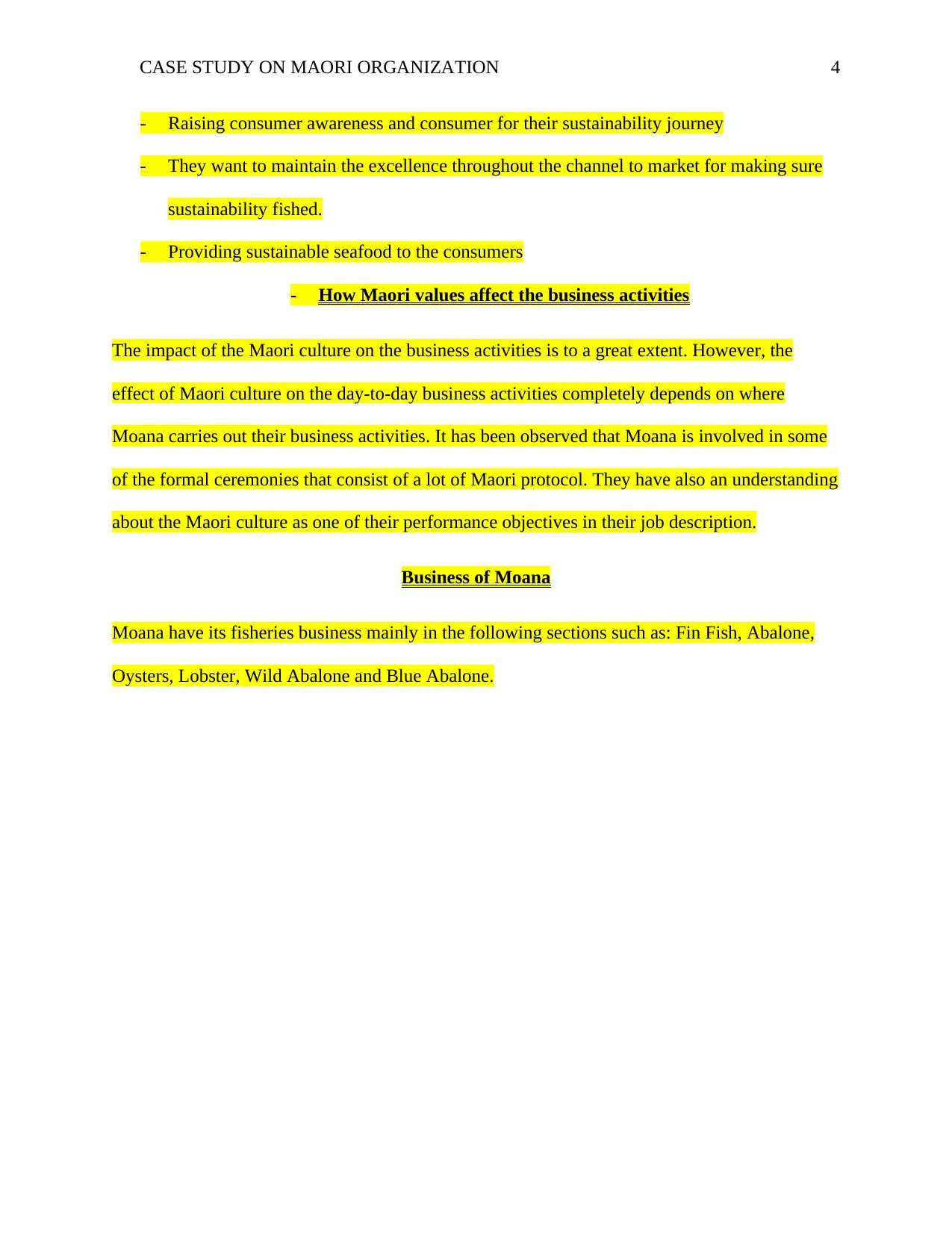
CASE STUDY ON MAORI ORGANIZATION 4
- Raising consumer awareness and consumer for their sustainability journey
- They want to maintain the excellence throughout the channel to market for making sure
sustainability fished.
- Providing sustainable seafood to the consumers
- How Maori values affect the business activities
The impact of the Maori culture on the business activities is to a great extent. However, the
effect of Maori culture on the day-to-day business activities completely depends on where
Moana carries out their business activities. It has been observed that Moana is involved in some
of the formal ceremonies that consist of a lot of Maori protocol. They have also an understanding
about the Maori culture as one of their performance objectives in their job description.
Business of Moana
Moana have its fisheries business mainly in the following sections such as: Fin Fish, Abalone,
Oysters, Lobster, Wild Abalone and Blue Abalone.
- Raising consumer awareness and consumer for their sustainability journey
- They want to maintain the excellence throughout the channel to market for making sure
sustainability fished.
- Providing sustainable seafood to the consumers
- How Maori values affect the business activities
The impact of the Maori culture on the business activities is to a great extent. However, the
effect of Maori culture on the day-to-day business activities completely depends on where
Moana carries out their business activities. It has been observed that Moana is involved in some
of the formal ceremonies that consist of a lot of Maori protocol. They have also an understanding
about the Maori culture as one of their performance objectives in their job description.
Business of Moana
Moana have its fisheries business mainly in the following sections such as: Fin Fish, Abalone,
Oysters, Lobster, Wild Abalone and Blue Abalone.
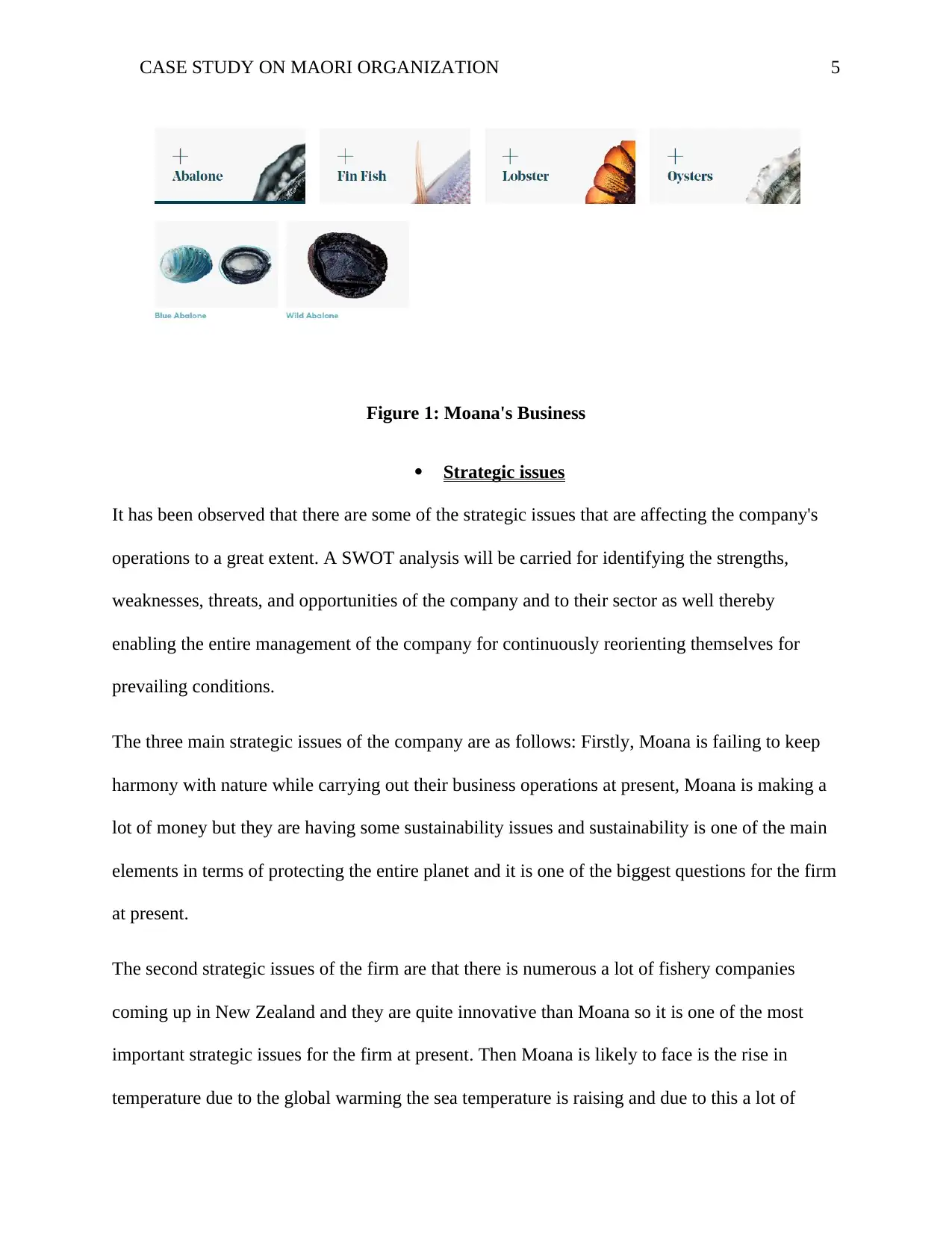
CASE STUDY ON MAORI ORGANIZATION 5
Figure 1: Moana's Business
Strategic issues
It has been observed that there are some of the strategic issues that are affecting the company's
operations to a great extent. A SWOT analysis will be carried for identifying the strengths,
weaknesses, threats, and opportunities of the company and to their sector as well thereby
enabling the entire management of the company for continuously reorienting themselves for
prevailing conditions.
The three main strategic issues of the company are as follows: Firstly, Moana is failing to keep
harmony with nature while carrying out their business operations at present, Moana is making a
lot of money but they are having some sustainability issues and sustainability is one of the main
elements in terms of protecting the entire planet and it is one of the biggest questions for the firm
at present.
The second strategic issues of the firm are that there is numerous a lot of fishery companies
coming up in New Zealand and they are quite innovative than Moana so it is one of the most
important strategic issues for the firm at present. Then Moana is likely to face is the rise in
temperature due to the global warming the sea temperature is raising and due to this a lot of
Figure 1: Moana's Business
Strategic issues
It has been observed that there are some of the strategic issues that are affecting the company's
operations to a great extent. A SWOT analysis will be carried for identifying the strengths,
weaknesses, threats, and opportunities of the company and to their sector as well thereby
enabling the entire management of the company for continuously reorienting themselves for
prevailing conditions.
The three main strategic issues of the company are as follows: Firstly, Moana is failing to keep
harmony with nature while carrying out their business operations at present, Moana is making a
lot of money but they are having some sustainability issues and sustainability is one of the main
elements in terms of protecting the entire planet and it is one of the biggest questions for the firm
at present.
The second strategic issues of the firm are that there is numerous a lot of fishery companies
coming up in New Zealand and they are quite innovative than Moana so it is one of the most
important strategic issues for the firm at present. Then Moana is likely to face is the rise in
temperature due to the global warming the sea temperature is raising and due to this a lot of
⊘ This is a preview!⊘
Do you want full access?
Subscribe today to unlock all pages.

Trusted by 1+ million students worldwide

CASE STUDY ON MAORI ORGANIZATION 6
fishes are dying. It impacts the current strategy of the company that is aligned with maintaining
proper sustainability.
The third strategic issue is poor communication among the employees and the management.
Communication is the key to everything no matter what and if it is weak then the entire business
tends to crumble down. No matter how good a company might be but if they have poor
communication then they have nothing. The communication channels used by Moana are quite
poor and that is the reason it is not helping the company to get the point across (Stokes, Gibbs &
Holland, 2006).
SWOT analysis
The strengths of Moana- they are one of the vast fisheries company in entire New Zealand.
Furthermore, they are also the second largest fish producers who are leaving behind their
potential competitors behind. Moana is the largest Maori-owned fisheries firm in entire New
Zealand. One of the potential strengths of the company is also that they tend to fish and harvest
fish completely from the entire coastal waters of New Zealand. It is the world's sustainably
managed and pristine fisheries that tend to connect their consumers with the taste of a pure along
with a true place that they will ever get. On the other hand, Moana is also true to nature as they
are successfully bringing their consumers New Zealand's most sought after the species with
regards to the wild abalone, blue abalone, oyster, as well as finish. Their seafood is the best
brought to the market with a touch that is quite light and it preserves as well as protects the rare
magic as well as a pure taste of the fishes. It clearly indicates the fact that the company in terms
of quality does not compromise at any cost. Furthermore, Māori organizations like Moana are
committed to the long road and the long term (Moana, 2015).
fishes are dying. It impacts the current strategy of the company that is aligned with maintaining
proper sustainability.
The third strategic issue is poor communication among the employees and the management.
Communication is the key to everything no matter what and if it is weak then the entire business
tends to crumble down. No matter how good a company might be but if they have poor
communication then they have nothing. The communication channels used by Moana are quite
poor and that is the reason it is not helping the company to get the point across (Stokes, Gibbs &
Holland, 2006).
SWOT analysis
The strengths of Moana- they are one of the vast fisheries company in entire New Zealand.
Furthermore, they are also the second largest fish producers who are leaving behind their
potential competitors behind. Moana is the largest Maori-owned fisheries firm in entire New
Zealand. One of the potential strengths of the company is also that they tend to fish and harvest
fish completely from the entire coastal waters of New Zealand. It is the world's sustainably
managed and pristine fisheries that tend to connect their consumers with the taste of a pure along
with a true place that they will ever get. On the other hand, Moana is also true to nature as they
are successfully bringing their consumers New Zealand's most sought after the species with
regards to the wild abalone, blue abalone, oyster, as well as finish. Their seafood is the best
brought to the market with a touch that is quite light and it preserves as well as protects the rare
magic as well as a pure taste of the fishes. It clearly indicates the fact that the company in terms
of quality does not compromise at any cost. Furthermore, Māori organizations like Moana are
committed to the long road and the long term (Moana, 2015).
Paraphrase This Document
Need a fresh take? Get an instant paraphrase of this document with our AI Paraphraser

CASE STUDY ON MAORI ORGANIZATION 7
When contrasted with other fishery companies in New Zealand such as New Zealand Fly Fishing
Company it has been observed that they are behind in providing best quality and variety of
products to their consumers.
Weaknesses of Moana- The fish stocks in New Zealand's deep-sea waters also remain untapped
owing to the dearth with regards to the fishing vessels that are suitable in nature. The second
weakness of the firm is that they have low-value addition as well as fish processing.
Furthermore, New Zealand also has no such coherent and organized efforts for implementing and
formulating some of the policies that will go well with the fishery companies like Moana in
terms of their fishery products especially for the domestic markets in which they are operating at
present. Furthermore, it has been also observed that the firm is not taking a long term view in
everything they are doing most of the time they work harmoniously with nature but still they fail
sometimes with regards to making sure of the sustainability of the fisheries for the future
generations (Stewart & Walshe, 2008).
When contrasted with Seafood New Zealand it has been noticed that this company works in
harmonious manner with the nature when conducting their business and they also makes sure
sustainability to the various fisheries so that they can also ensure the oceans they fish will be
blooming with full of life for the generations ahead.
Opportunities of Moana- Keeping aside the threats and the weaknesses there are plenty of
opportunities for Moana as the fishery industry in New Zealand is growing at an alarming rate.
There is a high amount of demand for the domestic freshwater fish in the country so Moana has a
bright opportunity to serve their consumers well in this segment. Moreover, people of New
Zealand in recent times are consuming fishes a lot more than they actually consumed before. The
company enhances the production of the fishes in rain fed water bodies by 4 times more. As
When contrasted with other fishery companies in New Zealand such as New Zealand Fly Fishing
Company it has been observed that they are behind in providing best quality and variety of
products to their consumers.
Weaknesses of Moana- The fish stocks in New Zealand's deep-sea waters also remain untapped
owing to the dearth with regards to the fishing vessels that are suitable in nature. The second
weakness of the firm is that they have low-value addition as well as fish processing.
Furthermore, New Zealand also has no such coherent and organized efforts for implementing and
formulating some of the policies that will go well with the fishery companies like Moana in
terms of their fishery products especially for the domestic markets in which they are operating at
present. Furthermore, it has been also observed that the firm is not taking a long term view in
everything they are doing most of the time they work harmoniously with nature but still they fail
sometimes with regards to making sure of the sustainability of the fisheries for the future
generations (Stewart & Walshe, 2008).
When contrasted with Seafood New Zealand it has been noticed that this company works in
harmonious manner with the nature when conducting their business and they also makes sure
sustainability to the various fisheries so that they can also ensure the oceans they fish will be
blooming with full of life for the generations ahead.
Opportunities of Moana- Keeping aside the threats and the weaknesses there are plenty of
opportunities for Moana as the fishery industry in New Zealand is growing at an alarming rate.
There is a high amount of demand for the domestic freshwater fish in the country so Moana has a
bright opportunity to serve their consumers well in this segment. Moreover, people of New
Zealand in recent times are consuming fishes a lot more than they actually consumed before. The
company enhances the production of the fishes in rain fed water bodies by 4 times more. As
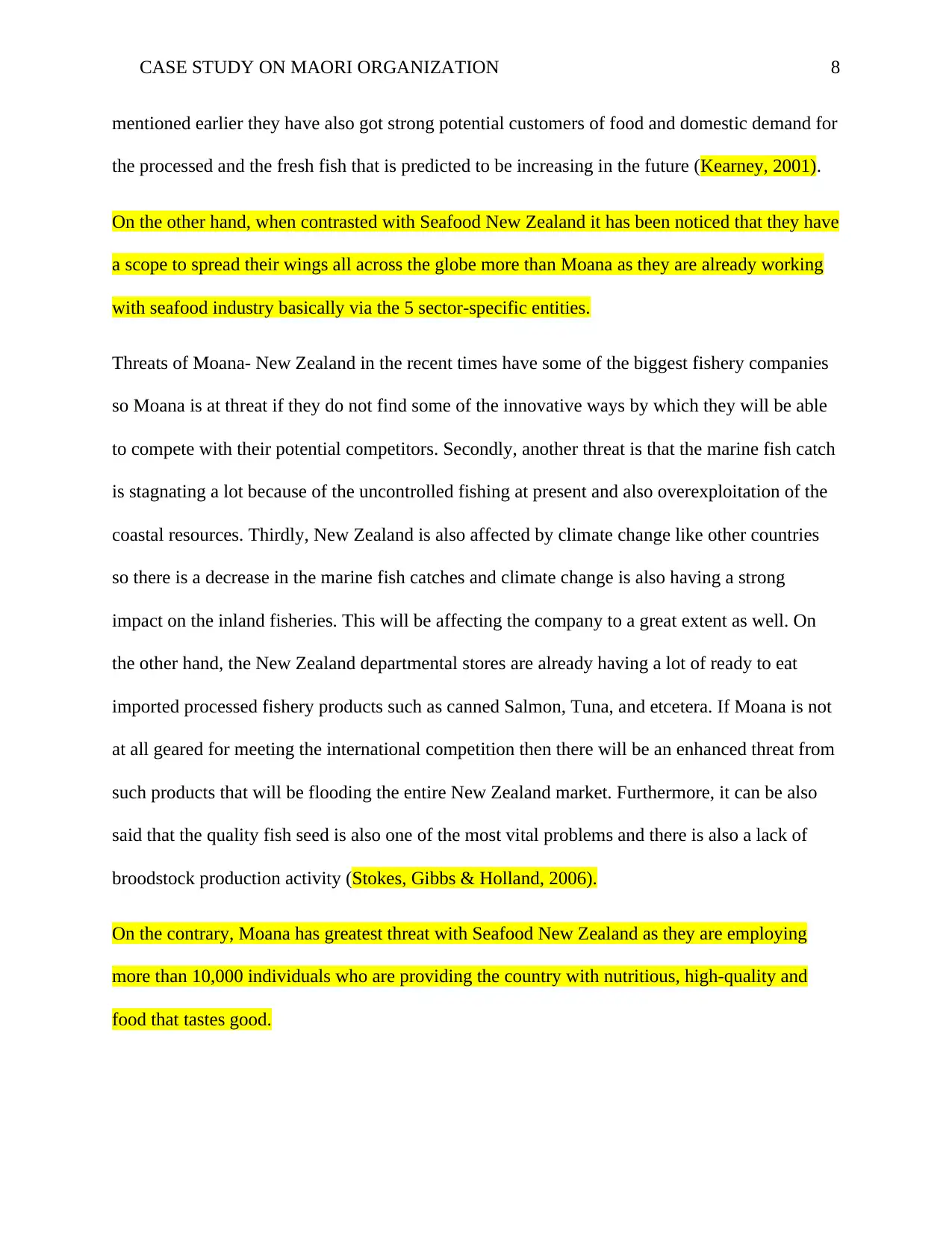
CASE STUDY ON MAORI ORGANIZATION 8
mentioned earlier they have also got strong potential customers of food and domestic demand for
the processed and the fresh fish that is predicted to be increasing in the future (Kearney, 2001).
On the other hand, when contrasted with Seafood New Zealand it has been noticed that they have
a scope to spread their wings all across the globe more than Moana as they are already working
with seafood industry basically via the 5 sector-specific entities.
Threats of Moana- New Zealand in the recent times have some of the biggest fishery companies
so Moana is at threat if they do not find some of the innovative ways by which they will be able
to compete with their potential competitors. Secondly, another threat is that the marine fish catch
is stagnating a lot because of the uncontrolled fishing at present and also overexploitation of the
coastal resources. Thirdly, New Zealand is also affected by climate change like other countries
so there is a decrease in the marine fish catches and climate change is also having a strong
impact on the inland fisheries. This will be affecting the company to a great extent as well. On
the other hand, the New Zealand departmental stores are already having a lot of ready to eat
imported processed fishery products such as canned Salmon, Tuna, and etcetera. If Moana is not
at all geared for meeting the international competition then there will be an enhanced threat from
such products that will be flooding the entire New Zealand market. Furthermore, it can be also
said that the quality fish seed is also one of the most vital problems and there is also a lack of
broodstock production activity (Stokes, Gibbs & Holland, 2006).
On the contrary, Moana has greatest threat with Seafood New Zealand as they are employing
more than 10,000 individuals who are providing the country with nutritious, high-quality and
food that tastes good.
mentioned earlier they have also got strong potential customers of food and domestic demand for
the processed and the fresh fish that is predicted to be increasing in the future (Kearney, 2001).
On the other hand, when contrasted with Seafood New Zealand it has been noticed that they have
a scope to spread their wings all across the globe more than Moana as they are already working
with seafood industry basically via the 5 sector-specific entities.
Threats of Moana- New Zealand in the recent times have some of the biggest fishery companies
so Moana is at threat if they do not find some of the innovative ways by which they will be able
to compete with their potential competitors. Secondly, another threat is that the marine fish catch
is stagnating a lot because of the uncontrolled fishing at present and also overexploitation of the
coastal resources. Thirdly, New Zealand is also affected by climate change like other countries
so there is a decrease in the marine fish catches and climate change is also having a strong
impact on the inland fisheries. This will be affecting the company to a great extent as well. On
the other hand, the New Zealand departmental stores are already having a lot of ready to eat
imported processed fishery products such as canned Salmon, Tuna, and etcetera. If Moana is not
at all geared for meeting the international competition then there will be an enhanced threat from
such products that will be flooding the entire New Zealand market. Furthermore, it can be also
said that the quality fish seed is also one of the most vital problems and there is also a lack of
broodstock production activity (Stokes, Gibbs & Holland, 2006).
On the contrary, Moana has greatest threat with Seafood New Zealand as they are employing
more than 10,000 individuals who are providing the country with nutritious, high-quality and
food that tastes good.
⊘ This is a preview!⊘
Do you want full access?
Subscribe today to unlock all pages.

Trusted by 1+ million students worldwide
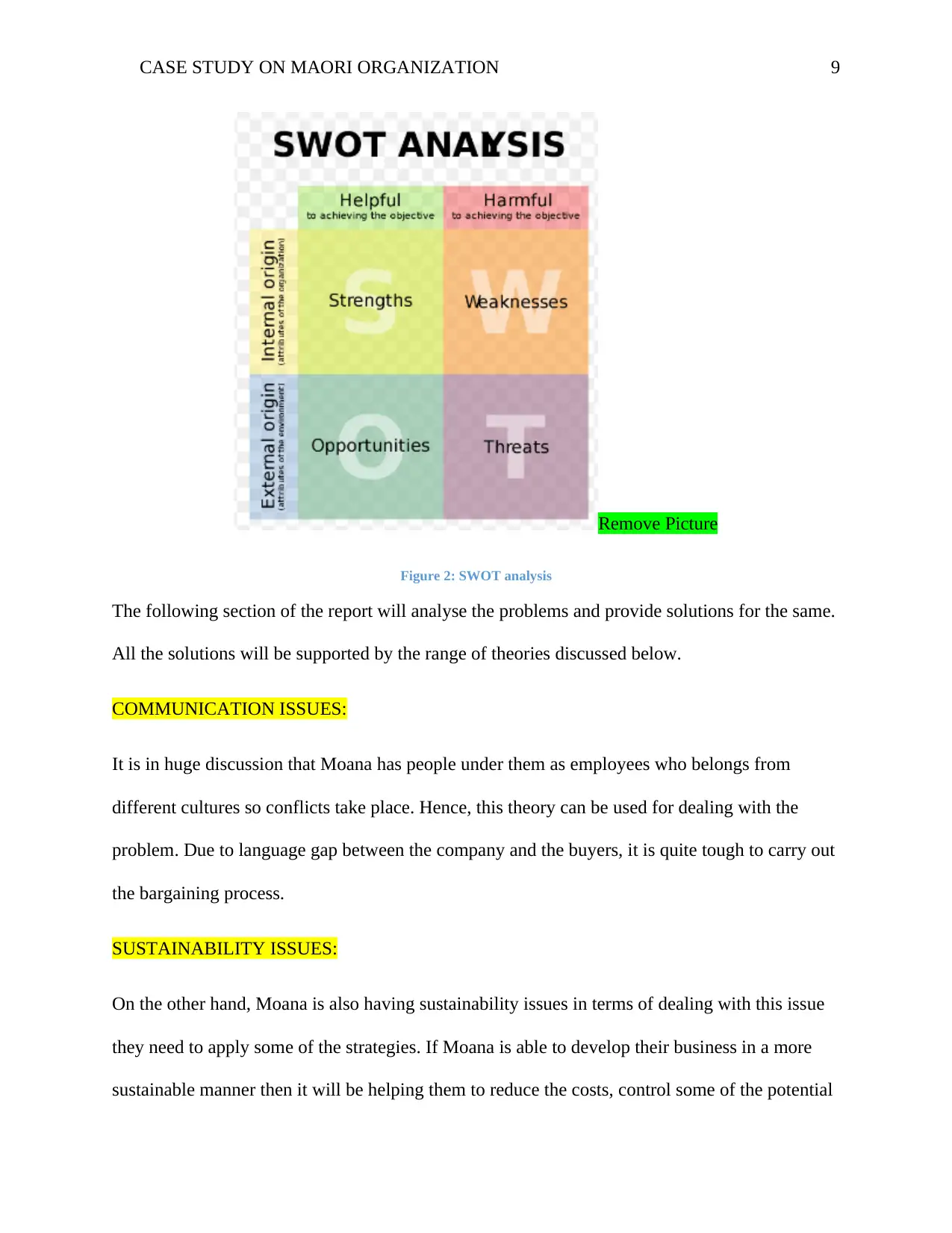
CASE STUDY ON MAORI ORGANIZATION 9
Remove Picture
Figure 2: SWOT analysis
The following section of the report will analyse the problems and provide solutions for the same.
All the solutions will be supported by the range of theories discussed below.
COMMUNICATION ISSUES:
It is in huge discussion that Moana has people under them as employees who belongs from
different cultures so conflicts take place. Hence, this theory can be used for dealing with the
problem. Due to language gap between the company and the buyers, it is quite tough to carry out
the bargaining process.
SUSTAINABILITY ISSUES:
On the other hand, Moana is also having sustainability issues in terms of dealing with this issue
they need to apply some of the strategies. If Moana is able to develop their business in a more
sustainable manner then it will be helping them to reduce the costs, control some of the potential
Remove Picture
Figure 2: SWOT analysis
The following section of the report will analyse the problems and provide solutions for the same.
All the solutions will be supported by the range of theories discussed below.
COMMUNICATION ISSUES:
It is in huge discussion that Moana has people under them as employees who belongs from
different cultures so conflicts take place. Hence, this theory can be used for dealing with the
problem. Due to language gap between the company and the buyers, it is quite tough to carry out
the bargaining process.
SUSTAINABILITY ISSUES:
On the other hand, Moana is also having sustainability issues in terms of dealing with this issue
they need to apply some of the strategies. If Moana is able to develop their business in a more
sustainable manner then it will be helping them to reduce the costs, control some of the potential
Paraphrase This Document
Need a fresh take? Get an instant paraphrase of this document with our AI Paraphraser
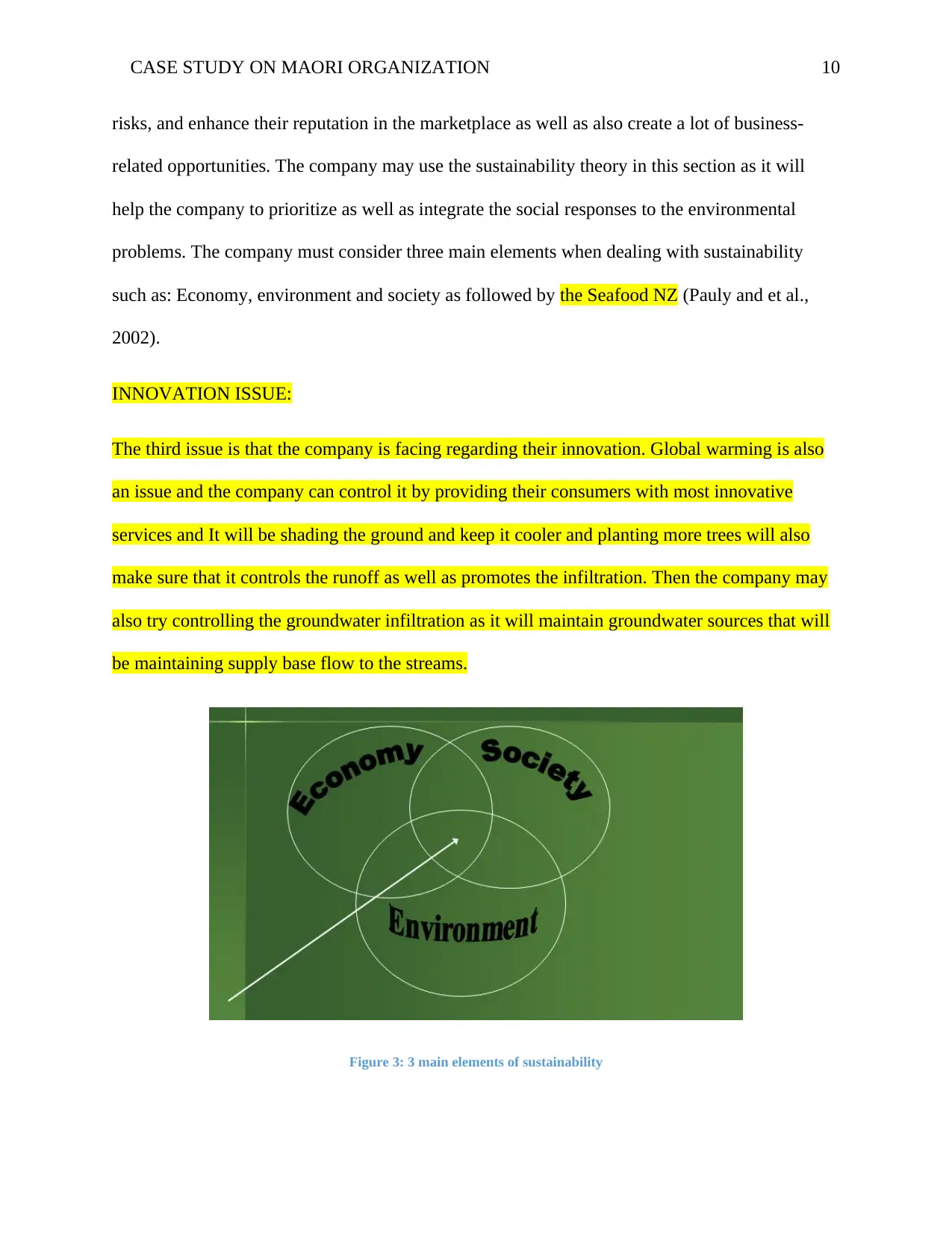
CASE STUDY ON MAORI ORGANIZATION 10
risks, and enhance their reputation in the marketplace as well as also create a lot of business-
related opportunities. The company may use the sustainability theory in this section as it will
help the company to prioritize as well as integrate the social responses to the environmental
problems. The company must consider three main elements when dealing with sustainability
such as: Economy, environment and society as followed by the Seafood NZ (Pauly and et al.,
2002).
INNOVATION ISSUE:
The third issue is that the company is facing regarding their innovation. Global warming is also
an issue and the company can control it by providing their consumers with most innovative
services and It will be shading the ground and keep it cooler and planting more trees will also
make sure that it controls the runoff as well as promotes the infiltration. Then the company may
also try controlling the groundwater infiltration as it will maintain groundwater sources that will
be maintaining supply base flow to the streams.
Figure 3: 3 main elements of sustainability
risks, and enhance their reputation in the marketplace as well as also create a lot of business-
related opportunities. The company may use the sustainability theory in this section as it will
help the company to prioritize as well as integrate the social responses to the environmental
problems. The company must consider three main elements when dealing with sustainability
such as: Economy, environment and society as followed by the Seafood NZ (Pauly and et al.,
2002).
INNOVATION ISSUE:
The third issue is that the company is facing regarding their innovation. Global warming is also
an issue and the company can control it by providing their consumers with most innovative
services and It will be shading the ground and keep it cooler and planting more trees will also
make sure that it controls the runoff as well as promotes the infiltration. Then the company may
also try controlling the groundwater infiltration as it will maintain groundwater sources that will
be maintaining supply base flow to the streams.
Figure 3: 3 main elements of sustainability
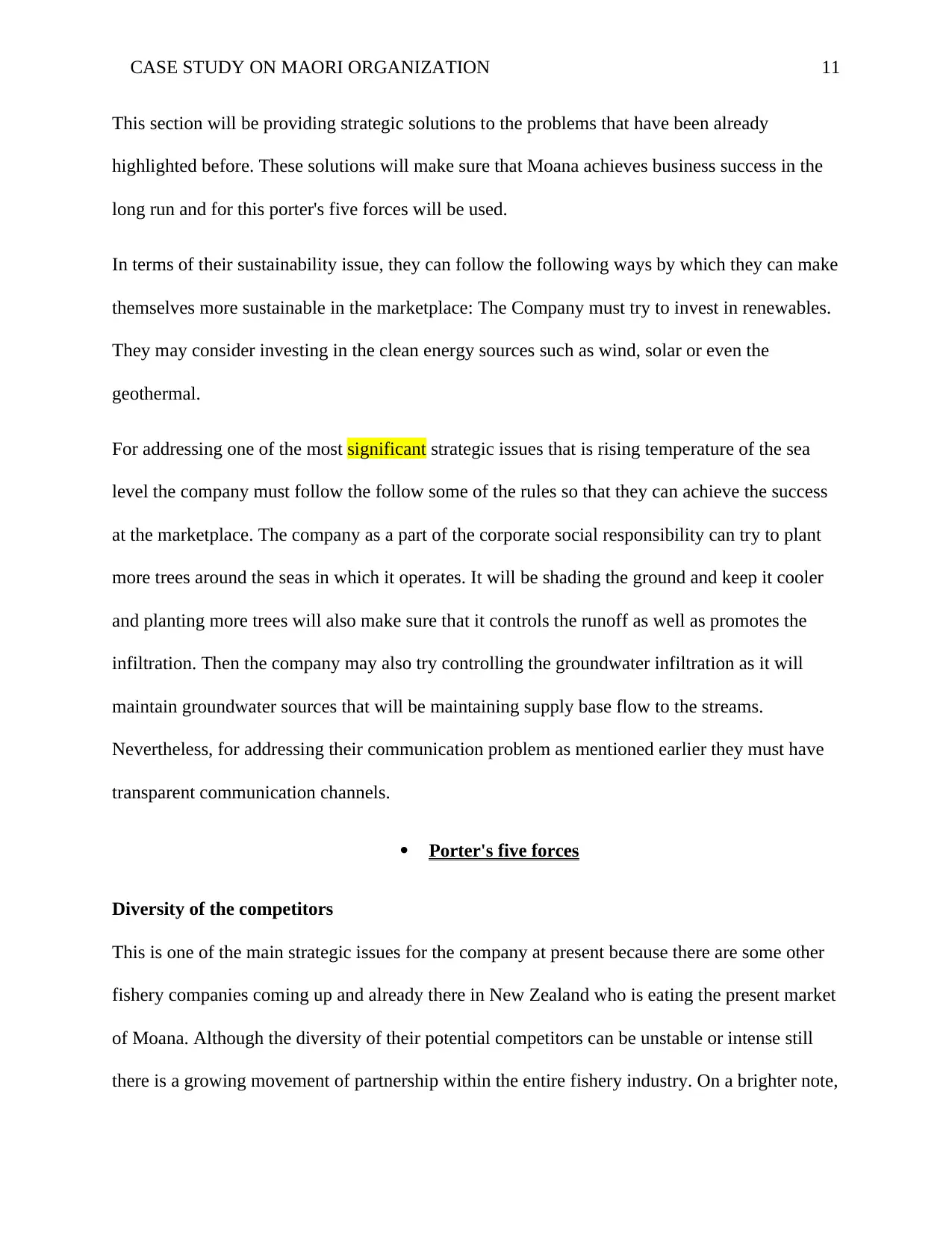
CASE STUDY ON MAORI ORGANIZATION 11
This section will be providing strategic solutions to the problems that have been already
highlighted before. These solutions will make sure that Moana achieves business success in the
long run and for this porter's five forces will be used.
In terms of their sustainability issue, they can follow the following ways by which they can make
themselves more sustainable in the marketplace: The Company must try to invest in renewables.
They may consider investing in the clean energy sources such as wind, solar or even the
geothermal.
For addressing one of the most significant strategic issues that is rising temperature of the sea
level the company must follow the follow some of the rules so that they can achieve the success
at the marketplace. The company as a part of the corporate social responsibility can try to plant
more trees around the seas in which it operates. It will be shading the ground and keep it cooler
and planting more trees will also make sure that it controls the runoff as well as promotes the
infiltration. Then the company may also try controlling the groundwater infiltration as it will
maintain groundwater sources that will be maintaining supply base flow to the streams.
Nevertheless, for addressing their communication problem as mentioned earlier they must have
transparent communication channels.
Porter's five forces
Diversity of the competitors
This is one of the main strategic issues for the company at present because there are some other
fishery companies coming up and already there in New Zealand who is eating the present market
of Moana. Although the diversity of their potential competitors can be unstable or intense still
there is a growing movement of partnership within the entire fishery industry. On a brighter note,
This section will be providing strategic solutions to the problems that have been already
highlighted before. These solutions will make sure that Moana achieves business success in the
long run and for this porter's five forces will be used.
In terms of their sustainability issue, they can follow the following ways by which they can make
themselves more sustainable in the marketplace: The Company must try to invest in renewables.
They may consider investing in the clean energy sources such as wind, solar or even the
geothermal.
For addressing one of the most significant strategic issues that is rising temperature of the sea
level the company must follow the follow some of the rules so that they can achieve the success
at the marketplace. The company as a part of the corporate social responsibility can try to plant
more trees around the seas in which it operates. It will be shading the ground and keep it cooler
and planting more trees will also make sure that it controls the runoff as well as promotes the
infiltration. Then the company may also try controlling the groundwater infiltration as it will
maintain groundwater sources that will be maintaining supply base flow to the streams.
Nevertheless, for addressing their communication problem as mentioned earlier they must have
transparent communication channels.
Porter's five forces
Diversity of the competitors
This is one of the main strategic issues for the company at present because there are some other
fishery companies coming up and already there in New Zealand who is eating the present market
of Moana. Although the diversity of their potential competitors can be unstable or intense still
there is a growing movement of partnership within the entire fishery industry. On a brighter note,
⊘ This is a preview!⊘
Do you want full access?
Subscribe today to unlock all pages.

Trusted by 1+ million students worldwide
1 out of 15
Related Documents
Your All-in-One AI-Powered Toolkit for Academic Success.
+13062052269
info@desklib.com
Available 24*7 on WhatsApp / Email
![[object Object]](/_next/static/media/star-bottom.7253800d.svg)
Unlock your academic potential
Copyright © 2020–2025 A2Z Services. All Rights Reserved. Developed and managed by ZUCOL.





